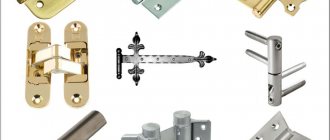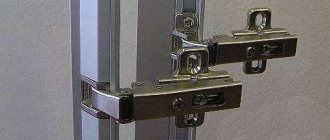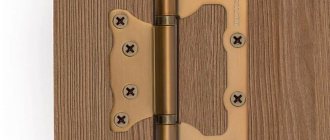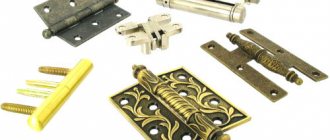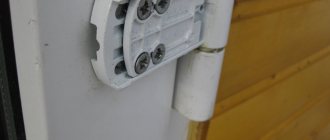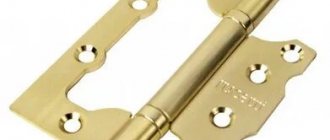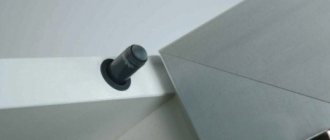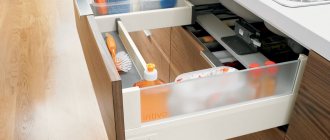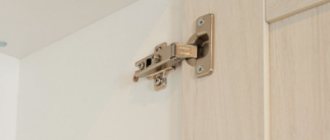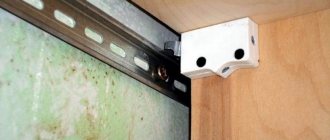Glass doors in cabinets create a showcase effect and look more beautiful than their chipboard counterparts. Souvenirs, dishes and books are visible when the wardrobe is closed, but accumulate dust. Hinges for glass doors are manufactured and installed taking into account the fragility of the material - their installation differs from classical facades. The fittings market is filled with several types of canopies for mirrors and stained glass windows. Let's consider the technology of mechanisms and the installation procedure.
Types of hinges for glass
All canopies are divided into two groups according to installation method. These are accessories that require drilling of the blade or are clamping devices.
You can make transparent doors in cabinets and cabinets with a solid fabric and install hinges without drilling. The second option is to enclose the glass in a metal frame made of stainless steel or aluminum and use canopies with drilling. Let's look at each type in more detail.
Glass in aluminum profile does not require drilling for hinges
With drilling
The design of the insert consists of a front cup and a counter lining. Installation requires mandatory glass drilling for fastening rotary fittings.
A decorative overlay is always attached to the front side
The inner and mating parts of the cup are fastened through the hole. Mortise fastenings are connected by simply screwing together both parts. The strike plate with the shoulder is secured with screws to the side post of the cabinet opening.
Expert opinion
Bashir Rabadanov
Technologist at the furniture company Woodband
Drill glass sheets up to 8 mm thick inclusive. Making doors from 10 mm or more glass is dangerous - their weight will be excessive for the hinges, which can be torn out of their mounting sockets in the cabinet body.
Articulated
Traditional designs of furniture hinges consist of hinges and have seals (gaskets), which we described above. Such canopies are used to secure hinged doors and are designed for a maximum load of up to 20 kg.
Materials
In the manufacture of glass hinges, materials with high strength and corrosion resistance are used. Let's look at them.
- Stainless steel. Metal with a polished surface looks attractive and can withstand significant operating loads. The outer part can be matte or glossy and goes well with glass.
- Silumin or aluminum. Non-ferrous soft metals with a silvery-white surface tint are used in inexpensive lightweight structures. When oxidized, aluminum, like alloys based on it, changes color to dull gray and requires periodic cleaning.
- Brass. The colored alloy has a characteristic golden color, often enhanced by additional decorative coating. The load-bearing capacity of such hinges is lower than that of steel ones, but in terms of aesthetics they are superior to other options.
These are the main metals that should be considered when selecting hinges for glass.
Ordinary steel is prone to corrosion and quickly loses its visual appeal, so it is rarely used without decorative chrome plating.
Built-in door closers
Glass is a fragile material. It is important that the doors close quietly and without knocking, otherwise the door may crack upon impact. Closers come to the rescue.
Door closer Blumotion 973-A
They can be built-in or independent. The price for such models is more expensive than classic ones. But you will be confident in the safety of fragile doors.
The closer is a spring or an oil shock absorber. Sometimes the mechanisms are filled with gas. If you decide to equip your glass doors with a shock-absorbing system yourself, you can do this in two ways: hang hinges with built-in closers or install stand-alone devices.
In Hafele, Resident and Leroy Merlin stores you will find glass hinges with built-in closers. Cheap Chinese companies build them into the hinge arm. Expensive fittings (Dorma, Blum) are equipped with closers in the seating cups of the hinges.
If you have already hung glass doors in your closet, then you do not need to change the hinges, just attach the autonomous closers to the screws. The pusher should protrude almost completely beyond the cabinet opening. The thrust piston should not prevent the door from closing completely.
How to choose glass hinges
Important factors to consider when purchasing a glass door pivot kit:
- maximum door opening angle:
- sash thickness and dimensions;
- weight of the glass sheet (and decorative decorations);
- appearance of the front part of the loop;
- complexity of installation (with and without drilling).
Don't skimp on accessories. Buy models from well-known manufacturers with built-in door closers.
MDM-Komplekt is an Italian company that has been supplying high-quality furniture fittings to Russia for many years.
Meroni Francesco has in its assortment authentic, exclusive and expensive models of glass hinges.
Dorma Russia is a leading supplier of door hardware in Russia, including glass door fastening systems, which are distinguished by their exquisite design and high reliability.
The Titan furniture company has its own distribution network, which sells a lot of glass accessories from leading manufacturers in Europe and Asia.
Hinges for glass furniture doors by installation method
Depending on the installation method, hinges can be attached:
- to the opening or door frame;
- to the floor and ceiling - option for swing doors;
- to the wall - this is for sliding doors;
- to another glass - this is for folding doors.
Universal furniture hinge
Furniture fittings are hinges that are attached to the opening or to other glass. In addition, hinges differ in purpose - furniture leaves and interior doors require different hinges, and in type of design - swing, pendulum, sliding. Swing hinges are used in furniture facades.
Popular models
In Russia, there is a large selection of furniture hinges for glass on the furniture fittings market. We have compiled an overview of the most popular models from well-known manufacturers in the form of a table:
| Model | Description | Price per set (4 pcs.), rub. |
| Blum Cristallo Blumotion 973 A | Overhead hinge with opening angle 125. Steel. | 615 |
| End hinge CHROME | Angles (closing/opening) 90/125 | 69 |
| End d 11 cr (MDM) | Angles 90/125. Glass 4 – 6 mm. Chromium. | 364 |
| Clamping loop Meroni gaha1 st6d | 620 | |
| Clamping loop Blum GDH 70 | Chromium. | 1500 |
The best manufacturers
There are dozens of hinge options on the market suitable for use with glass structures, but not all brands are trustworthy. The highest quality fittings of this type are made in EU countries: Germany, Czech Republic, Italy.
Among them we can highlight Dorma, a German company and a recognized market leader. Italian Metalglas is also among the leaders. Among the popular brands are such manufacturers from Germany as WSS, Paul + Sohn GmbH. Russian companies are represented by the brands Atlantic, Kinlong, and Orman.
Drilling installation
To install a glass door with holes, overhead, semi-overlay and inset hinges are used. They come with landing cups with a diameter of 26 and 35 mm. The distance between the edge of the hole and the edge of the glass is 4 – 8 mm. You will need to make 2 holes in the glass sheet.
The action plan is as follows:
- Make markings for installing hinges on the canvas and cabinet body. Remember that the holes for installing the cup should be located somewhere ten to twelve centimeters from the top and bottom of the glass; on the sides they should recede somewhere between three and five millimeters. The diameter of the hole is equal to the cup of the loop.
- Drill holes according to the markings using a drill with a special cutter with a diamond attachment under running water. If you are unable to do this yourself, order such work to be performed in a workshop by a qualified worker with special equipment.
- Insert the hinge cup into the slot from the back side of the facade.
- Place the counter part on top of the cup, tighten both parts with screws, which should be included in the hinge kit. If they are not there, contact the store where you bought the accessories and report the shortage.
- Make a mark on the cabinet body to install the hinge arm by leaning the glass against the installation site and marking the fastening points with a pencil or thin marker.
- Drill holes according to the markings with a drill.
- Attach the arm to the cabinet stand in the traditional way - with screws.
- Adjust the loop with special bolts located on the body.
- Cover the finished connection with a decorative cover.
Installation of stop hinges without drilling
Use end loops here. The procedure is as follows:
- Drill holes for pins in the bottom and top of the cabinet frame. They must be exactly above each other and at the same distance from the wall!
- Install hinges in the corners of the opening.
- Place protective pads in the grooves.
- Insert the corners of the glass into the grooves of the hinges and clamp them with the clamping bar and screws until they stop.
- Make sure everything is level and secure.
- Install decorative elements if they are provided by the manufacturer.
Installation of clamping loops without drilling
When installing a hinge with a clip under glass, proceed in the following order:
- Select a location for installation. The hinges should be located at a distance of approximately five to seven centimeters from the top and edge of the glass, respectively.
- Make a mark on the surface on which you will hang the door. Pay attention to the locations of fasteners!
- Drill holes in the housing, take a screwdriver or screwdriver and attach one part of the hinge.
- Insert the glass sheet into the clamp and adjust the position of the door relative to the cabinet body.
- Secure the glass. For such precise work, use hand tools. A cordless screwdriver may slip and damage the fragile surface.
- If necessary, install decorative trims.
Between the glass and the metal there should be spacers made of plastic, rubber or glue to protect against possible damage. Fix the glass sheet carefully; the clamping bolts should not be overtightened.
Peculiarities
The main features of glass hinges are directly related to their purpose. Since through fastening is not the best option, other methods of fixation are used here. Most often this is installation in special clamps that can withstand significant loads during operation. This is especially important in frameless designs where there is no wood or metal edging.
When installing in wet rooms, attention is paid to the corrosion resistance of materials, and sometimes heat resistance, as is the case with fastening doors in saunas and walls in shower cabins.
One of the important requirements is the aesthetics of the hinges, because they remain visible on the surface of transparent glass. With frameless mounting, these elements are selected so that they look attractive and have a symmetrical design without defects. One of the key parameters is the size of the loops. Elements that are too large will spoil the overall appearance of the door or other hanging structure.
The presence of protective elements is another important distinguishing feature of specialized fasteners. Glass hinges are equipped with special gaskets made of flexible and elastic polymers. This avoids damage to the glass sash.
Adjustment
You can adjust the hinges as follows:
- The central screw on the shoulder is “responsible” for the position of the blade in its plane. Turning it left or right, install the door exactly with the edges of the opening.
- The end screw is installed in the shoulder slot. By loosening the fastening, achieve even gaps between the door and the perimeter of the opening. After adjustment, be sure to tighten the screw back.
- Using the screws of the trim strip on the opening post, move the door vertically.
- Using special pads under the hinge arms, you can set the desired door opening angle.
The end hinges with the location of the support sockets in the horizontal panels of the opening are not adjustable. Therefore, when drilling seats, you need to be very careful and avoid miscalculations.
